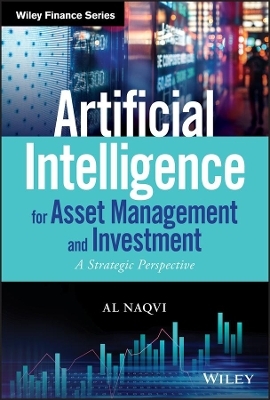
Artificial Intelligence for Asset Management and Investment
John Wiley & Sons Inc (Verlag)
978-1-119-60182-1 (ISBN)
The rise of artificial intelligence is nothing short of a technological revolution. AI is poised to completely transform asset management and investment banking, yet its current application within the financial sector is limited and fragmented. Existing AI implementations tend to solve very narrow business issues, rather than serving as a powerful tech framework for next-generation finance. Artificial Intelligence for Asset Management and Investment provides a strategic viewpoint on how AI can be comprehensively integrated within investment finance, leading to evolved performance in compliance, management, customer service, and beyond.
No other book on the market takes such a wide-ranging approach to using AI in asset management. With this guide, you’ll be able to build an asset management firm from the ground up—or revolutionize your existing firm—using artificial intelligence as the cornerstone and foundation. This is a must, because AI is quickly growing to be the single competitive factor for financial firms. With better AI comes better results. If you aren’t integrating AI in the strategic DNA of your firm, you’re at risk of being left behind.
See how artificial intelligence can form the cornerstone of an integrated, strategic asset management framework
Learn how to build AI into your organization to remain competitive in the world of Fintech
Go beyond siloed AI implementations to reap even greater benefits
Understand and overcome the governance and leadership challenges inherent in AI strategy
Until now, it has been prohibitively difficult to map the high-tech world of AI onto complex and ever-changing financial markets. Artificial Intelligence for Asset Management and Investment makes this difficulty a thing of the past, providing you with a professional and accessible framework for setting up and running artificial intelligence in your financial operations.
AL NAQVI is the CEO of the American Institute of Artificial Intelligence, where he designs and develops machine learning based finance products, teaches classes on applied AI, deep learning, and cognitive transformation, and leads the company strategy. He studies the application of deep learning to financial engineering, investment, and asset management. He is also the author of Artificial Intelligence for Audit, Forensic Accounting, and Valuation (Wiley).
Preface xv
Acknowledgments xxi
Chapter 1: AI in Investment Management 1
What about AI Suppliers? 5
Listening without Judging 6
The Four Stages of AI in Investments 9
The Core Model of AIAI 14
Your Journey through This Book 16
How to Read and Apply this Book? 16
References 17
Chapter 2: AI and Business Strategy 19
Why Strategy? The Red Button 19
AI—a Revolution of its Own 21
Intelligence as a Competitive Advantage 22
Intelligence as a Competitive Advantage and Various Strategy Schools 23
The Intelligence School 25
Intelligence and Actions 26
Actions 27
Automation 28
Intelligence Action Chain and Sequence 28
Enterprise Software 29
Data 29
Competitive Advantage 30
Business Capabilities 31
Chapter 3: Design 35
Who Is Responsible for Design? 36
Introduction to Design 36
AI as a Competitive Advantage 38
The Ten Elements of Design 40
1. Design Your Business Model 41
2. Set Goals for the Entire Firm 44
3. Specify Objectives for Automation and Intelligence 45
4. Design Work Task Frames Based on Human-Computer Interaction 45
5. Perform a DTC (Do, Think, Create) Analysis 46
6. Create a SADAL Framework 47
7. Deploy a Feedback System and Define Performance Measures 49
8. Determine the Business Case or Value 49
9. Analyze Risks 50
10. Develop a Governance Plan 50
Some Additional Ideas about Designing Intellectualization 50
Summary of the Design Process 51
References 52
Chapter 4: Data 53
Who Is Responsible for the Data Capability? 53
Data and Machine Learning 55
Raw Data 55
Structured vs. Unstructured Data 56
Data Used in Investments 57
Data Management Function for the AI Era 58
Step 1: Data Needs Assessment (DNA) 59
Step 2: Perform Strategic Data Planning 59
Step 3: Know the Sensors and Sources (Identify Gaps) 61
Step 4: Procure and Understand the Supply Base 61
Step 5: Understand the Data Type (Signals) 62
Step 6: Organize Data for Usability 62
Step 7: Architect Data 63
Step 8: Ensure Data Quality 63
Step 9: Data Storage and Warehousing 63
Step 10: Excel in Data Security and Privacy 63
Step 11: Implement Data for AI 64
Step 12: Provide Investment Specialization 65
About Legacy Data Management 66
References 67
Chapter 5: Model Development 69
Who Is Responsible? 69
High-Level Process 70
Models 73
The Power of Patterns 74
Techniques of Learning 75
What Is Machine Learning? 76
Scientific Process on Steroids 79
The Learning Machines 79
Algorithms 80
Supervised Learning 82
Supervised: Classification 85
Classification: Random Forest 86
Classification: Using Mathematical Functions 87
Classification: Simple Linear Classifier 88
Supervised: Support Vector Machine 91
Classification: Naive Bayes 94
Classification: Bayesian Belief Networks 95
Classification: k-Nearest Neighbor 95
Supervised: Regression 96
Supervised: Multidimensional Regression 99
Unsupervised Learning 100
Neural Networks 103
Reinforcement Learning 106
References 107
Chapter 6: Evaluation 109
Who Performs the Evaluation? 109
Problems 111
Making the Model Work 111
Overfitting and Underfitting 113
Scale and Machine Learning 113
New Methods 114
Bias and Variance 115
Backtesting 116
Backtesting Protocol 119
References 121
Chapter 7: Deployment 123
Reference Architecture 127
The Reference Architecture and Hardware 130
References 131
Chapter 8: Performance 133
Who Is Responsible for Performance? 134
What Are the Work Processes of Performance? 134
Business Performance 136
Technological Performance 138
References 141
Chapter 9: A New Beginning 143
Building an Investment Management Firm Around Artificial Intelligence? 144
The Fallacy of Going Digital 145
Why Build Your Firm Around AI? 148
You Must Rely on Your Own Capabilities 149
What Is Asset Science? 150
A Healthy Cycle 154
The Tool Set 155
This Is Not Just Automation 156
References 157
Chapter 10: Customer Experience Science 159
Customer Experience 159
Value, Strength, and Duration of Relationship 160
Understanding Customers: Empathy for CX 161
Steps to Become an Empathetic Asset Management Firm 162
Know Your Empmeter 162
Expand Empathy Awareness and Understanding 163
Incorporate into Products and Services 163
What Is Automated Empathy and Compassion (AEC)? 163
Incorporating AEC Marketing 165
References 168
Chapter 11: Marketing Science 171
Who Undertakes This Responsibility? 171
How to Apply AI for Marketing 172
Begin with Assessment 172
Know Your Data 174
The AI Plan for Asset Management Marketing 176
Perform Strategic Planning 176
Manage Product Portfolio with AI 179
Transform Your Communications 180
Build Relationships 181
Execute with Excellence 181
References 182
Chapter 12: Land that Institutional Investor with AI 183
Who Is Responsible for IRMS Automation? 183
Is IRMS Your CRM System? 184
Know Thyself: Automated Self-Discovery 184
Automated Asset Class Analysis 185
Automated Institutional Analysis 185
Automated Structure and Terms Analysis 186
Automated Fee Analysis 186
Automated Communications 186
Unleash the Power of Knowing 188
Chapter 13: Sales Science 189
What Is Sales Science? 189
Who Is Responsible for Implementing Sales Science? 190
Are You Driving This in Sales? 190
How to Build Your AI-Based Sales System 193
References 195
Chapter 14: Investment: Managing the Returns Loop 197
Who Is Responsible for Investment Management? 197
How to Approach Building the New-Era Investment Function? 198
The Core Tool Set 204
What Will Be the Function of Your Investment Lab? 206
Make the Decisions 206
A New World 207
The (Unnecessary) Debate 208
More Behaviors 208
Research and Investment Strategy 209
Portfolio 210
Performance 210
References 210
Chapter 15: Regulatory Compliance and Operations 213
Who Is Responsible? 213
Regulatory Compliance 213
Why Intelligent Automation? 214
Have You Scoped Out What to Do? 215
How to Do It? 215
How to Use Technology for GIPS Implementation? 217
Back and Middle Office 219
Chapter 16: Supply Chain Science 221
Who Is Responsible for Supply Chain Science? 221
How to Think about Supply Chains 222
References 225
Chapter 17: Corporate Social Responsibility 227
CSR Woes: Can Processes Explain Them? 227
What Are the Criticisms of CSR? 228
Measurement Issues 228
Behavioral and Role Issues 230
Strategic and Organizational Issues 230
How to Apply AI in CSR? 231
CSR Must Not Be Forgotten 232
ESG Investment 232
How Can AI Help? 234
You Must Avoid These Mistakes 236
Summary Steps 236
References 237
Chapter 18: AI Organization and Project Management 241
The New Asset Management Organization 241
Why a CAIO/COO Role? 243
What Is Changing? 244
How to Get There? 244
Issues of the New Organization 246
Change Management 248
Managing AI Projects 249
References 250
Chapter 19: Governance and Ethics 251
Corporate Governance with AI 251
Governance of AI 257
Framing the Ethical Problems from a Pragmatic Viewpoint 261
Some Obvious Ethical Issues 262
Humans and AI 262
Ethics Charter 263
References 264
Chapter 20: Adaptation and Emergence 267
The Revolution Is Real 268
Complex Adaptive Systems 270
Our Coronavirus Meltdown Prediction 271
Index 273
| Erscheinungsdatum | 09.04.2021 |
|---|---|
| Reihe/Serie | Wiley Finance |
| Verlagsort | New York |
| Sprache | englisch |
| Maße | 160 x 234 mm |
| Gewicht | 522 g |
| Themenwelt | Wirtschaft ► Betriebswirtschaft / Management |
| ISBN-10 | 1-119-60182-7 / 1119601827 |
| ISBN-13 | 978-1-119-60182-1 / 9781119601821 |
| Zustand | Neuware |
| Haben Sie eine Frage zum Produkt? |
aus dem Bereich


